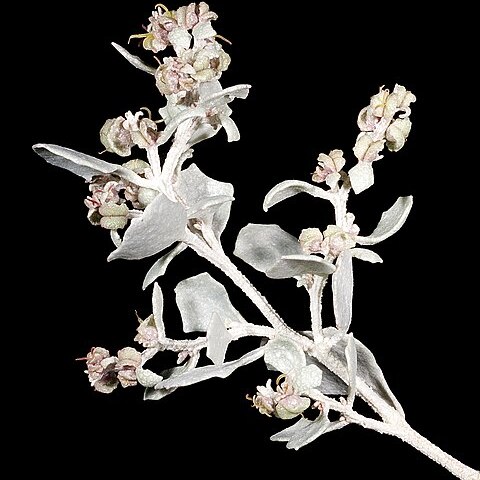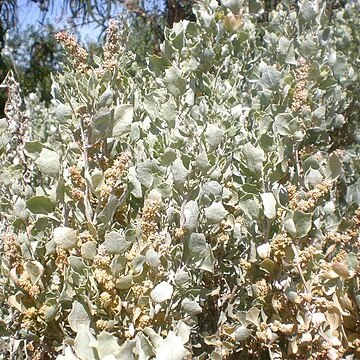Erect shrub to 3 m high, predominantly dioecious. Leaves broadly elliptic to ovate or obovate, obtuse, denticulate to coarsely dentate, smooth, grey-green; lamina 2–4 cm long, petiole 0.5–1 cm long. Male flowers in disjunct glomerules c. 6 mm diam. arranged in panicles. Female flowers in compact clusters arranged in panicles c. 20 cm long. Fruiting bracteoles sessile; valves free, orbicular to rhomboidal, 5–15 mm long, 5–11 mm wide, entire or denticulate, rounded at apex, cuneate to cordate at base, papery or thickened towards base around seed; appendages absent.
Herbs perennial, to 2 m tall. Stems erect, much branched, slightly ribbed. Leaves shortly petiolate; leaf blade ovate to rhombic-ovate, usually 1-1.5 × 0.6-1 cm, furfuraceous, base subcuneate to broadly cuneate, decurrent, margin with 1-3 pairs of undulate teeth, or entire, apex rounded to subobtuse. Inflorescences axillary glomerules borne toward apex of branches, forming small panicles. Fruiting bracts connate at base, semiorbicular, ca. 7 mm wide, basal central part swollen and hardened, margins green, with finely undulate teeth.
A perennial herb. It grows 1-3 m tall. It spreads 2-4 m wide. The branches are whitish. The leaves are furry and silvery white. They are 4 cm long by 4 cm wide. They are flat with teeth along the edge. The flowers are small. The flowers are yellowish-brown. The male flowers are round and in clusters at the end of the plant. The female flowers are in long dense clusters at the ends of plants. Male and female flowers are on separate plants.
Dense shrub, 1-3 m high, branches whitish, brittle, woody. Leaves bluish grey, 40 x 40 mm, flat, margins toothed, covered by mealy grey to white, vesicular scales. Inflorescences greyish, yellow-brown; male flowers in terminal clusters, female flowers in compact, long, terminal clusters. Flowering time Sept.-Jan. (all year). Fruiting bracts ± 5 mm long, ± oval.
Greyish green, predominantly dioecious shrub, up to 3 m tall, with creamy white stems. Leaves oval to triangular. Male flowers in separate glomerules arranged in panicles. Female flowers in compact clusters arranged in panicles. Fruiting bracteoles enlarging and surrounding seed, fan-shaped, attached at base only.


